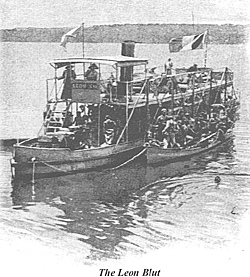 The First Gentil Mission 1897
The First Gentil Mission 1897
Gentil’s mission set out from Brazzaville in the French Congo on his steamer, the Léon Blot in 1897.
The mission comprised of Gentil, with two other Frenchmen, Huntzbuchler and de Mostuéjouls, and Ahmed, their Arab interpreter. They were supported with a platoon of 50 Tirailleurs and 4 servants. The Léon Blot steamed up the Congo and into its tributary, the Ubangi river and then into the headwaters of the Tomi as far as Krebedje, the site where Fort Sibut was later established. Here the boat was dismantled and carried over land to the Gribingi River where Fort Crampel was later established. For the next several months, Gentil explored the river systems of the Gribingi and in August 1897 entered the main Shari River steaming down stream into Bagirmi.
The Léon Blot arrived at Massenya, the makeshift capital of the virtually exiled Sultan Gaorang. Here, Gaorang entertained Gentil for two weeks. During this period, Gentil received information that led him to believe that Rabih was responsible for the massacre of the Crampel mission.
Gaorang sought French allegiance and a conference was concluded with a treaty placing Bagirmi under French Protectorate. The treaty conformed to international law. Rabih was aware of Gentil’s arrival in Bagirmi through his spy network, which fed intelligence back to Dikwa. Rabih was at first skeptical, but sent another spy for confirmation. While docked at Massenya, the Léon Blot was approached by the spy who was able to speak with one of the French Officers on the boat. However, they spy was unable to obtain accurate information of Gentil’s strength. Cautious, due to this lack of information, Rabih withdrew his garrisons from the Shari River.
Gentil proceeded down the Shari, passing both Kusseri and Gulfei without any opposition and entered Lake Chad in October of 1897. Rabih, informed of the Léon Blot’s passage, rode to Kusseri to intervene in its return up the Shari. Rabih arrived at Kusseri, a fortified town consisting of two story buildings with a population of 12,000, only to find that Gentil had passed back north the night before.
Rabih was furious at the town’s lack of opposition. He launched punitive raids on Kusseri and Gulfei massacring many of the populations and carrying others into slavery. This rampage spread throughout Bagirmi as Rabih sought to impress his subjects that the French were not to pass unhindered into his empire again. In the face of this approaching rampage, Gaorang destroyed Massenya and fled south towards the French, having an army with only 400 firearms, he was no match for Rabih’s hordes.
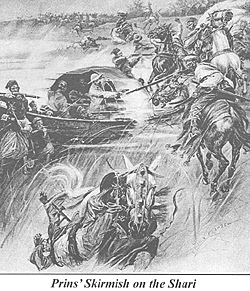 On returning south, Gentil met with the French Administrator of the region Pierre Prins. Prins had been traveling into Dar Runga and had met with Sansui. Gentile returned to France leaving Prins to administer the treaty with Gaorang.
On returning south, Gentil met with the French Administrator of the region Pierre Prins. Prins had been traveling into Dar Runga and had met with Sansui. Gentile returned to France leaving Prins to administer the treaty with Gaorang.
Prins used this time to explore the river systems where he increased his knowledge of Rabih’s empire due to the large numbers of refugees fleeing south into Bagirmi to escape his tyranny. To hold back the advance of Rabih’s retaliatory attacks, Prins organized the Bagirmi army north of Massenya, and burnt a huge swath across the land to 1 degree of latitude, as a no-mans land. This apparently worked, as Rabih moved back to Dikwa, but not before he had carried off another 30,000 Bagirmians into slavery.
The Bagirmi army under Gaorang, with the assistance of Prins used this opportunity to subjugate the Boa, vassals of Bagirmi but who had begun to resist them with the aid of deserters from Rabih’s army.
De Béhagle, a French adventurer employed by a business consortium to explore trade opportunities in the Chad basin, arrived on the Léon Blot. Prins and De Béhagle steamed down stream towards Kusseri on a reconnaissance. Before entering the Logone, they were held up by sandbanks and attempted to land. Cavalry from one of Rabih’s strongholds of 1000 men attacked them. After a brief skirmish, Rabih’s forces were repulsed.
After the attack, the Frenchmen were visited by Uthman Sheku commander of the 10th banner, who apologized for the attack and invited the men to Dikwa. Prins refused, not trusting the offer, but Béhagle accepted, and with six tirailleurs was escorted to Rabih at Kusseri.
Prins returned to Kuno. From Kusseri, Béhagle was taken to Dikwa and became the first European to meet with Rabih on a peaceful mission. After their initial meeting, Béhagle was left to his own devises and wandered Dikwa. Rabih became suspicious of Béhagle who was making copious notes. After an argument with Rabih, Béhagle was chained and became a prisoner.
The Second Gentil Mission and The Battle of Kuno 1899
The imprisonment of Béhagle was another step in ensuring a military response from the French, who had, until this point held out hopes of a negotiated settlement with Rabih. The military response began when Bretonnet arrived in Gribingi. Prins left Kuno, south, to meet him.
A grand colonial plan, perceived in Paris, was for three missions to converge on the center of Africa in the region of Lake Chad. The Sahara mission was organized by Foureau financed by the Geographic Society of Paris and private business sponsorships. Lamy was to provide the military support. This mission traveled south through the heart of the Sahara. The West African mission of Voulet Chanoine was to travel east from Senegal, while the third mission, under Gentil, was to begin in Brazzaville, retracing his earlier steps. That the three missions might actually rendezvous at Lake Chad appears to have been thought a possibility, but was hardly considered as a likely outcome.
The Gentil mission arrived in Brazzaville with a company of tirailleurs raised in Senegal on the way from France. Henri Bretonnet, a veteran of the Dahomey campaign and prior expeditions into West Africa, preceded it. Bretonnet’s command consisted of Senegalese tirailleurs and Congolese tirailleurs raised in Brazzaville and Lieutenant Braun of the Marine Artillery. Bretonnet advanced north down the Shari River as Gentil’s vanguard. His mission was to organize Gaorang’s forces in Bagirmi, whom Prins had informed of the imminent arrival of further French reinforcements.
Meanwhile, Gentil, with the rank of Administrator 1st Class organized the main force. His senior officers were Cavalry Capitaine Robillet, Capitaine Cointet, a veteran of Madagascar, Capitaine Lamothe (Gentil’s nephew) le Docteur Sibut, and Administrateur Bruel and Pinel and Gentil’s assistant and friend de Mostuéjouls. Also in the force were a Lieutenant de Tirailleurs Algeriens M. Kieffer, Maréchal de Logic Baugnies and Levassor and three Arab interpreters.
Added to the mission was Capitaine Julien whose company if 150 tirailleurs were preparing to reinforce the Marchand mission at Fashoda. Capitaine Cointet’s company was of 137 Tirailleurs raised by Gentil in Senegal on the way from France. Capitaine Lamothe provided 80 men on arrival at Brazzaville.
Bretonnet moved north east, to Ndele, al Sansui’s capital, and arrived in May 1899 reporting little of concern. He sent officers west to Bagirmi to rendezvous with Gaorang’s Bagirmian army. Bretonnet from here traveled to Kuno on the West Bank of the Shari River and linked up with Gaorang’s army. Here he met up with Prins who informed him of Béhagle’s departure for Bornu with one of Rabih’s Generals.
While he had been in Ndele, Bretonnet had courted al Sansui as a potential ally against Rabih, not appreciating Sansui’s vassalage of Rabih. This had led al Sansui to convey information to Rabih of the French intent. Consequently, Rabih mobilized 11 of his banners and a large number of auxiliaries and marched up the Shari, to oppose the French.
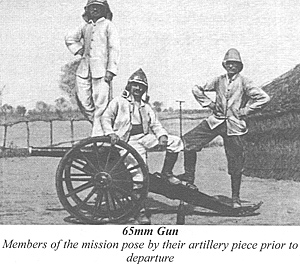 Bretonnet arrived in Kuno on the 15 June 1899. Being alerted to Rabih’s advance, and uncertain of his ability to successfully defend Kuno, retreated south to the Nyellim hills that he felt were more defensible. On July 16, Bretonnet sent a message to Gentile requesting reinforcements.
Bretonnet arrived in Kuno on the 15 June 1899. Being alerted to Rabih’s advance, and uncertain of his ability to successfully defend Kuno, retreated south to the Nyellim hills that he felt were more defensible. On July 16, Bretonnet sent a message to Gentile requesting reinforcements.
Meanwhile, Gentil had been preparing his forces at Gribingi (Fort Crampel). On August 3 he received the message from Bretonnet and departed north with Julien’s company and two pieces of 65mm artillery. The Léon Blot was armed with a 37mm rapid-fire cannon and a Hotchkiss 5-barreled 37mm rotary cannon. As they passed Guara on August 16, Sergeant Samba Saul was spotted on the bank.
Landing there, Gentil was informed of the battle of Nyellim hills (see part 1), the destruction of the French, the rout of the Bagirmian army and the death of Bretonnet. Gentile, finding himself isolated in a hostile country with no allies, landed at Guara and built a blockhouse as a defensive position. It was named Fort Archambault (after a young lieutenant who had died earlier that year) and garrisoned with Julien’s company and the two 65mm cannons under the overall command of Capitaine Robillet. Gentile went for reinforcements and returned in October with Capitaines Lothone and Cointet.
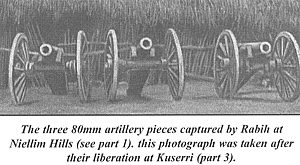 After Nyellim hills, Rabih reorganized at Kuno. From this force, Rabih detached six banners to Lai, south west of Kuno on the Logone River. This was tasked with re-supplying Rabih’s forces at Kuno and also with attempting to locate Gaorang’s army and preventing their re-joining the French. Five banners remained at Kuno, the 2nd, 10th, the 15th and Rabih’s bodyguard 28th and 29th banners. Rabih had been reinforced with several auxiliary contingents from the Kotoko states. These consisted of at least 460 spearmen and 54 horse warriors and 15 muskets armed warriors. Also, from Dikwa, 850 spear armed warriors in 70 war canoes from Kusseri. The 80mm mountain guns captured at Nyellim hills were also available. The village of Kuno lies inland from the bank so as not to be viewable from the water. Here Rabih constructed a circular palisade of logs, raised on an earthen bank preceded by a ditch. In this fortification he placed his two bodyguard banners and two of the artillery pieces. Rabih was resorting to his tried and tested defensive strategies perfected more than a decade earlier. The third 80mm gun, under the command of Uthman Sheku, was placed further forward towards the river with a good overview of the approach permitting a field of fire to the Léon Blot. On high ground on the bank, overlooking a sandbank in the river, Rabih placed his three remaining banners and those auxiliaries as could find space.
After Nyellim hills, Rabih reorganized at Kuno. From this force, Rabih detached six banners to Lai, south west of Kuno on the Logone River. This was tasked with re-supplying Rabih’s forces at Kuno and also with attempting to locate Gaorang’s army and preventing their re-joining the French. Five banners remained at Kuno, the 2nd, 10th, the 15th and Rabih’s bodyguard 28th and 29th banners. Rabih had been reinforced with several auxiliary contingents from the Kotoko states. These consisted of at least 460 spearmen and 54 horse warriors and 15 muskets armed warriors. Also, from Dikwa, 850 spear armed warriors in 70 war canoes from Kusseri. The 80mm mountain guns captured at Nyellim hills were also available. The village of Kuno lies inland from the bank so as not to be viewable from the water. Here Rabih constructed a circular palisade of logs, raised on an earthen bank preceded by a ditch. In this fortification he placed his two bodyguard banners and two of the artillery pieces. Rabih was resorting to his tried and tested defensive strategies perfected more than a decade earlier. The third 80mm gun, under the command of Uthman Sheku, was placed further forward towards the river with a good overview of the approach permitting a field of fire to the Léon Blot. On high ground on the bank, overlooking a sandbank in the river, Rabih placed his three remaining banners and those auxiliaries as could find space.
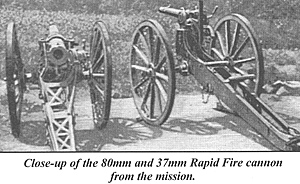 After re-equipping and leaving a detachment of 20 men and a 65mm gun at Fort Archambault, Gentiles force totaled 344 men, two 80mm mountain guns, a 65mm gun and the two pieces on the Léon Blot. Two companies advanced down stream on the west bank of the river flanked by the Léon Blot towing a steel barge. On October 29 1899, the Léon Blot drew in sight of Rabih’s forces.
After re-equipping and leaving a detachment of 20 men and a 65mm gun at Fort Archambault, Gentiles force totaled 344 men, two 80mm mountain guns, a 65mm gun and the two pieces on the Léon Blot. Two companies advanced down stream on the west bank of the river flanked by the Léon Blot towing a steel barge. On October 29 1899, the Léon Blot drew in sight of Rabih’s forces.
Capitaine Robillet approached the rear of Kuno. His two companies were reinforced by the third, which landed just before Kuno. The three companies in echelon were able to approach Rabih position without being discovered. Rabih had expected the attack to come solely from the river. Robillet had advance through the underbrush staying off the trails.
The Léon Blot was prevented from closing on the shore due to the large sandbank, but approached effective artillery range, at 9.00 in the morning. Gentil was able to clearly see Rabih’s troops on the cliffs by the bank, their leaders dressed all in white, their kidney pouches clearly visible, waiving their arms and encouraging their men. The two cannons on the boat, and rifles from crew not otherwise engaged, opened fire from the Léon Blot. At almost the same moment, from less than 1500 meters, the three pieces of artillery with Robillet also opened fire. Rabih was shocked for a moment at the two pronged attack, but quickly recovered and began to return fire from the fortifications. Uthman Sheku’s artillery piece began to return fire on the steamer.
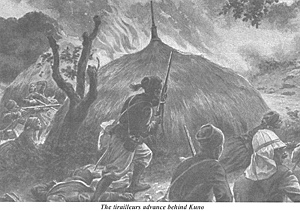 The three tirailleur companies had advanced slowly, unsure of their positions in the bush, finding the village with difficulty. As Rabih’s defensive positions were within the city the advance was at first unaware of the fortifications. The French artillery opened fire on the huts that could be seen. To the left of their advance, Rabih has placed some skirmishers in a small hollow that began to fire effectively into the lead-company. Behind the hollow, more of Rabih’s bazingers revealed themselves and engaged the lead-company in a fierce firefight.
The three tirailleur companies had advanced slowly, unsure of their positions in the bush, finding the village with difficulty. As Rabih’s defensive positions were within the city the advance was at first unaware of the fortifications. The French artillery opened fire on the huts that could be seen. To the left of their advance, Rabih has placed some skirmishers in a small hollow that began to fire effectively into the lead-company. Behind the hollow, more of Rabih’s bazingers revealed themselves and engaged the lead-company in a fierce firefight.
This effectively halted the French advance. The mountain gun under Uthman Sheku joined the fusillade pinning down half a section of the third (reserve) company. Captain Robillet ordered “fix bayonets” and charged the enemy position. Rabih’s bazingers, lacking bayonets collapsed back into Kuno with the charging tirailleurs hot on their heels.
The first section to the buildings set fire to them, which quickly spread into an inferno of burning huts and corals, causing horses and cattle within their confines to stampede. Protected by the obscuring smoke and fire, the rest of the tirailleurs advanced to the hut line, methodically firing into the irregular but intense gunfire received from Rabih’s regrouping bazingers.
The banners fell back on their stockade of palm tree trunks, still as yet, unseen by the French. The artillery piece was also withdrawn, pausing to issue fire as it retreated. The French followed up, until the palisade fortifications were spotted, barely 100 meters from their front.
Meanwhile, on the Léon Blot, Gentil fired into the banners gathered on the cliffs by the bank. Before it re-targeted onto the advancing infantry and fell back to the stockade, Uthman Sheku’s artillery had fired on the Léon Blot several times. Its rounds either fell short or passed over the heads of Gentil’s steamer. The Léon Blot’s constant moving prevented Sheku from accurately targeting it. Some shells came very close, their Melanite charges cracked loudly around the steamer, its crew soaked by one near miss that exploded in the water. The bazingers musketry proved far more accurate, but the steel plates erected around the vessel for protection was very effective and no casualties were taken aboard the steamer except for the cook, Louis, who received a ball in the leg around midday.
About the same time, the bazingers on the cliffs, under constant fire from the 37mm rapid-fire canon and the Hotchkiss rotary cannon, began to waver. A large section of the bazingers was seen to break and run down stream. Gentil concentrated his fire on this group with great effect. The remaining auxiliaries were stiffened with more regular banner troops and intensified their fire on the Léon Blot.
Monsieur Pahouine was on the roof of the steamer in the watchtower calling out the fall of shot and giving correcting fire. This proved effective and a round from the Hotchkiss revolving canon brought down Uthman Sheku. He could be clearly seen from the steamer, falling against a tree, being aided by his soldiers who surrounded him, but to no avail, a second round from the canon killed him. At the loss of their commander, the banner and auxiliaries began to waiver again and many peeled off in rout or retreated into the stockade (still unseen from the steamer). The Léon Blot headed after a large group of routers along the bank pouring fire into them.
The steamer soon returned to the position near the town but the fire from the remaining banners was sporadic and dying down. More ammunition was brought up from the barge and re-supplied to the steamer’s artillery and to the companies on the shore. As they re acquired their position, the boat’s crew was able to see their tirailleurs charge the fortifications, their position revealed by the sun glinting off of their bayonets.
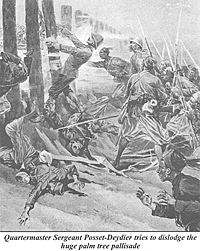 Captain Julien led the charge with the first company, the second in support with the third in reserve. The attack closed on the palisade under an intense fire from Rabih’s bodyguard banners. The assault was unable to traverse the log wall, it being too high for them and the fire too intense. Quartermaster Sergeant Possel-Deydier at the head of his section grabbed hold of one of the massive tree-trunk pilings and shook it with all his might, but it was too solid. Two bullets cut him down and four of his tirailleurs who tried to assist him were also killed. His body was recovered by Lieutenant Galland who carried him back to the cover of the huts, to where the rest of section fell back.
Captain Julien led the charge with the first company, the second in support with the third in reserve. The attack closed on the palisade under an intense fire from Rabih’s bodyguard banners. The assault was unable to traverse the log wall, it being too high for them and the fire too intense. Quartermaster Sergeant Possel-Deydier at the head of his section grabbed hold of one of the massive tree-trunk pilings and shook it with all his might, but it was too solid. Two bullets cut him down and four of his tirailleurs who tried to assist him were also killed. His body was recovered by Lieutenant Galland who carried him back to the cover of the huts, to where the rest of section fell back.
Quartermaster Sergeant Posset-Deydier tries to dislodge the huge palm tree pallisade.
Captain Julien rallied his men. The artillery under Warrant Officer Delpierre and gunner Guégan put up a formidable barrage from 70 meters that prevented Rabih from following up the French fallback.
This stalemate remained for three more hours. Rabih’s forces continued to take considerable losses including that of Faki Ahmed and Ibrahim, commander of the 28th bodyguard banner. Even Babikir, Rabih’s faithful second in command, was mortally wounded. He urged Rabih to make one more sortie from the fortifications, but other advisers persuaded Rabih against this. He maintained his position within the palisade, desperately holding on. The furious firefight continued until 4:30, when the French realized that they could not take the fortifications and began their withdrawal up stream and regrouped on the sand bank.
Both sides suffered heavy casualties. Rabih lost 78 bazingers and a large number of auxiliaries killed. Babikir died later, during the evacuation along with many more of his bazingers who had been wounded at Kuno. During their retreat, down the east bank of the Shari, to safeguard from an attack by Gaorang’s army, tribes still hostile to Rabih attacked them.
The French lost 46 dead and 106 wounded. After expending 50,000 rounds of rifle ammunition and 900 artillery rounds, the men were down to an average 60 rounds each, insufficient for any kind of follow up attack. Consequently, the French retired up stream to Fort Archambault where they learned that Gaorang was on his way to join them.
The result could well have swung either way had, either the French been reinforced by Gaorang’s army, or if Rabih’s banners had returned from Lai.
In part three, the French columns of Voulet-Chanoine and Foureau-Lamy meet with Gentil’s at Lake Chad and engage Rabih in his final battle, at Kusseri.
African Warlord: Central Sudan, 1884 – 1911 Part 2
-
Part Two: Rise to Dominance
Part Two: Rabih's Army
Part Two: Organization of the Banners (very slow: 212K)
Part Two: Gentil's Missions 1897-1899
Part Two: Jumbo Color Illustration: Rabih's Warriors (slow: 319K)
African Warlord: Central Sudan, 1884 – 1911 Part 1
-
Part One: Battle of Nyellim Hills
Part One: A Leader Emerges
Part One: The Years Under Sulaiman
Part One: Azande Warfare
Part One: Jumbo Map of Central Sudan (slow: 116K)
Back to Table of Contents -- Courier # 88
To Courier List of Issues
To MagWeb Master Magazine List
© Copyright 2003 by The Courier Publishing Company.
This article appears in MagWeb.com (Magazine Web) on the Internet World Wide Web.
Other articles from military history and related magazines are available at http://www.magweb.com